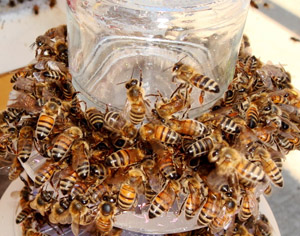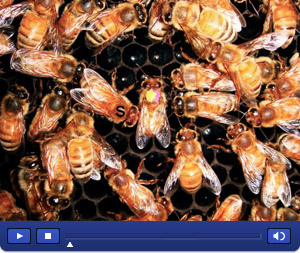Biologist Discovers 'Stop' Signal in Honey Bee Communication
February 11, 2010
By: Kim McDonald
A biologist at UC San Diego has discovered that honey bees warn their nest mates about dangers they encounter while feeding with a special signal that's akin to a "stop" sign for bees.
The discovery, detailed in a paper in the February 23 issue of the journal Current Biology, which appears online today, resulted from a series of experiments on honey bees foraging for food that were attacked by competitors from nearby colonies fighting for food at an experimental feeder. The bees that were attacked then produced a specific signal to stop nest mates who were recruiting others for this dangerous location. Honey bees use a waggle dance to communicate the location of food and other resources. Attacked bees directed "stop" signals at nest mates waggle dancing for the dangerous location.
James Nieh, an associate professor of biology at UCSD who conducted the experiments, said this peculiar signal in bee communication was known previously by scientists to reduce waggle dancing and recruitment to food, but until now no one had firmly established a "clear natural trigger" for that behavior.
The stop sign is a brief vibrating signal made by the bee that lasts for about a tenth of a second with the bee vibrating at about 380 times a second. "It is frequently delivered by a sender butting her head into a recipient, although the sender may also climb on top of the receiver," Nieh said.
Bee researchers originally called it a "begging call," because they believed the signaling bee made it to obtain a food sample from the receiver.
But Nieh discovered in his experiments that one trigger for this signal-which caused the waggle dancers to stop and leave the nest-was attacks from bee competitors and simulated predators. The more dangerous the predator or competitor, he found, the more the stop signals bees produced to stop other bees from recruiting to that location.

The waggle dancer (at center with yellow and pink paint marks) is frozen when receiving a stop signal from a bee marked "S" to her left.
"This signal is directed at bees who are recruiting for the dangerous food location and decreases their recruitment," explained Nieh. "Thus, fewer nest mates go to the dangerous food site. This is important because an individual experiences danger and stops recruiting, but the stop signal enables her to 'warn' nest mates who have not yet experienced danger and are still recruiting. The end result is that the colony will reduce or cease recruitment to the dangerous food patch in proportion to the danger experienced."
Nieh found in his experiments that during aggressive food competition, attack victims significantly increased their production of stop signals to nest mates, some by more than 40 times. Bees foraging for food that attacked other bees or experienced no aggression did not produce stop signals. But bees exposed to a "bee alarm pheromone" increased their stop signaling by an average of 14 times. Those whose legs were mechanically pinched in a simulated bite increased their stop signals by an average of 88 times.
Nieh said that cooperation within and between cells in an organism relies upon positive and negative feedback. "Superorganisms," such as honey bees, are like a multi-cellular organism because each individual bee, just like a body cell, acts for the good of the whole, the colony. Superorganisms use many types of positive feedback signals, but there are few known examples of negative feedback signals.
What's interesting to biologists about the discovery of the stop sign, Nieh said, is that it's an example of a negative feedback, in which the colony's actions are stopped for the good of the colony.
"This is only the second example of a negative feedback signal ever found in a superorganism and is perhaps the most sophisticated example known to date," he said.
Nieh was assisted in his experiments by UC San Diego undergraduate volunteers working in his laboratory. His study was supported by the UC San Diego Opportunities for Research in Behavioral Sciences Program, which is supported by the National Science Foundation. ORBS is a program for high school students and undergraduates that provides research experience for students who are traditionally underrepresented in the sciences.
Related Links
